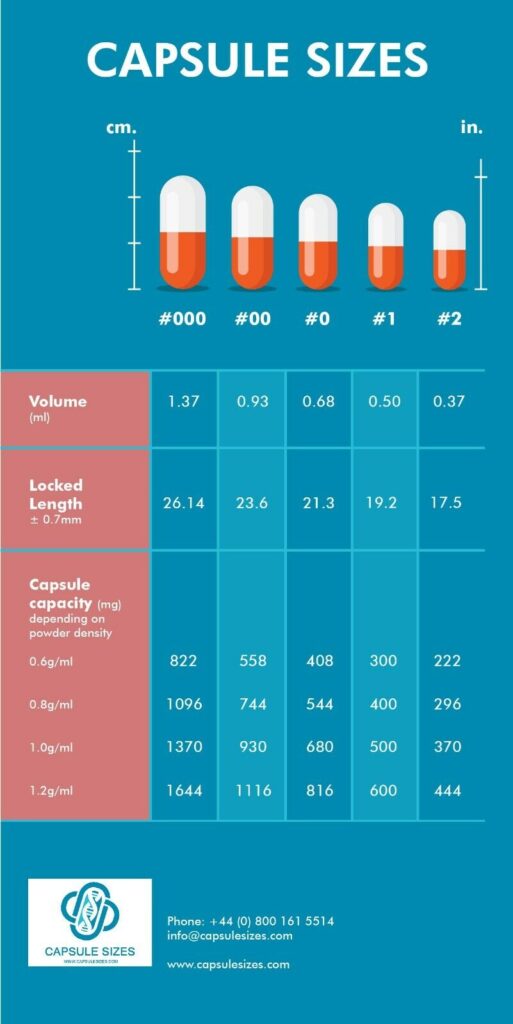Capsule sizes can vary significantly, impacting both the amount of material they can hold and their suitability for different age groups or swallowing abilities. Here’s a general capsule size chart, ranging from largest to smallest, that is commonly used in the industry. This chart provides an overview of the most popular sizes, their dimensions, and typical capacity ranges for powder filling. Keep in mind, capacities can vary based on the density and properties of the materials being encapsulated.

Capsule Size Chart
- 000 (Triple Zero): Largest size generally available, with a capacity of about 800-1600 mg. Dimensions are approximately 9.7-10.4 mm in diameter and 26-28 mm in length.
- 00 (Double Zero): A very popular size for a wide range of applications, holding about 600-1100 mg. Dimensions are around 8-9 mm in diameter and 23-25 mm in length.
- 0 (Zero): Holds approximately 400-800 mg. Dimensions are about 7-8 mm in diameter and 21-23 mm in length.
- 1: Slightly smaller, suitable for those who have difficulty with larger capsules, with a capacity of about 300-600 mg. Dimensions are roughly 6-7 mm in diameter and 19-21 mm in length.
- 2: A medium-small size, holding around 200-400 mg. Dimensions are approximately 5-6 mm in diameter and 18-19 mm in length.
- 3: Small size, generally used for medications and supplements where lower dosages are required, with a capacity of about 150-300 mg. Dimensions are around 5.5 mm in diameter and 15.5 mm in length.
- 4: Even smaller, with a capacity of around 100-200 mg. This size is often used for pediatric or veterinary applications. Dimensions are about 5 mm in diameter and 14 mm in length.
- 5: The smallest size commonly used, suitable for very small doses, holding about 60-130 mg. Dimensions are roughly 4.5 mm in diameter and 11 mm in length.
Additional Notes:
- The capacities mentioned are approximate and can vary based on the powder’s density and the capsule material.
- Besides the powder capacity, the choice of capsule size may also depend on the intended use (e.g., for adults, children, pets), the type of supplement or medication, and the ease of swallowing required.
- Capsule sizes “000” to “5” are the most commonly used, but there are also specialized sizes available for specific needs, including veterinary or experimental applications.
- The dimensions provided are for gelatin and HPMC capsules, which are the most common types. Other materials may have slightly different dimensions due to material properties.
When choosing a capsule size for a particular application, consider both the volume of material to be encapsulated and the end user’s ability to swallow the capsule.
